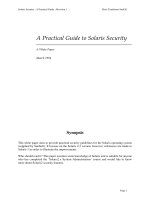Python for offensive pentest a practical guide to ethical hacking and penetration testing using python
Bạn đang xem bản rút gọn của tài liệu. Xem và tải ngay bản đầy đủ của tài liệu tại đây (4.5 MB, 180 trang )
Python for Offensive PenTest
A practical guide to ethical hacking and penetration testing using Python
Hussam Khrais
BIRMINGHAM - MUMBAI
Python for Offensive PenTest
Copyright © 2018 Packt Publishing
All rights reserved. No part of this book may be reproduced, stored in a retrieval system, or transmitted in any form or by any means,
without the prior written permission of the publisher, except in the case of brief quotations embedded in critical articles or reviews.
Every effort has been made in the preparation of this book to ensure the accuracy of the information presented. However, the
information contained in this book is sold without warranty, either express or implied. Neither the author, nor Packt Publishing or its
dealers and distributors, will be held liable for any damages caused or alleged to have been caused directly or indirectly by this book.
Packt Publishing has endeavored to provide trademark information about all of the companies and products mentioned in this book by the
appropriate use of capitals. However, Packt Publishing cannot guarantee the accuracy of this information.
Commissioning Editor: David Barnes
Acquisition Editor: Namrata Patil
Content Development Editor: Dattatraya More
Technical Editors: Nirbhaya Shaji and Sayali Thanekar
Copy Editor: Laxmi Subramanian
Project Coordinator: Shweta H Birwatkar
Proofreader: Safis Editing
Indexer: Pratik Shirodkar
Graphics: Jisha Chirayil
Production Coordinator: Arvindkumar Gupta
First published: April 2018
Production reference: 1250418
Published by Packt Publishing Ltd.
Livery Place
35 Livery Street
Birmingham
B3 2PB, UK.
ISBN 978-1-78883-897-9
www.packtpub.com
mapt.io
Mapt is an online digital library that gives you full access to over 5,000 books and videos, as well as
industry leading tools to help you plan your personal development and advance your career. For more
information, please visit our website.
Why subscribe?
Spend less time learning and more time coding with practical eBooks and Videos from over
4,000 industry professionals
Improve your learning with Skill Plans built especially for you
Get a free eBook or video every month
Mapt is fully searchable
Copy and paste, print, and bookmark content
PacktPub.com
Did you know that Packt offers eBook versions of every book published, with PDF and ePub files
available? You can upgrade to the eBook version at www.PacktPub.com and as a print book customer, you
are entitled to a discount on the eBook copy. Get in touch with us at for more
details.
At www.PacktPub.com, you can also read a collection of free technical articles, sign up for a range of free
newsletters, and receive exclusive discounts and offers on Packt books and eBooks.
Contributors
About the author
Hussam Khrais is a senior security engineer, GPEN, and CEHHI with over 7 years of experience in
penetration testing, Python scripting, and network security. He spends countless hours forging custom
hacking tools in Python. He currently holds the following certificates in information security:
GIAC Penetration Testing (GPEN)
Certified Ethical Hacker (CEH)
Cisco Certified Network Professional - Security (CCNP Security)
Packt is searching for authors like you
If you're interested in becoming an author for Packt, please visit authors.packtpub.com and apply today.
We have worked with thousands of developers and tech professionals, just like you, to help them
share their insight with the global tech community. You can make a general application, apply for a
specific hot topic that we are recruiting an author for, or submit your own idea.
Table of Contents
Title Page
Copyright and Credits
Python for Offensive PenTest
Packt Upsell
Why subscribe?
PacktPub.com
Contributors
About the author
Packt is searching for authors like you
Preface
Who this book is for
What this book covers
To get the most out of this book
Download the example code files
Download the color images
Conventions used
Get in touch
Reviews
1.
Warming up – Your First Antivirus-Free Persistence Shell
Preparing the attacker machine
Setting up internet access
Preparing the target machine
TCP reverse shell
Coding a TCP reverse shell
Server side
Client side
Data exfiltration – TCP
Server side
Client side
Exporting to EXE
HTTP reverse shell
Coding the HTTP reverse shell
Server side
Client side
Data exfiltration – HTTP
Client side
Server side
Exporting to EXE
Persistence
Making putty.exe persistent
Making a persistent HTTP reverse shell
Tuning the connection attempts
Tips for preventing a shell breakdown
Countermeasures
Summary
2.
Advanced Scriptable Shell
Dynamic DNS
DNS aware shell
Interacting with Twitter
Parsing a tweet in three lines
Countermeasures
Replicating Metasploit's screen capturing
Replicating Metasploit searching for content
Target directory navigation
Integrating low-level port scanner
Summary
3.
Password Hacking
Antivirus free keylogger
Installing pyHook and pywin
Adding code to keylogger
Hijacking KeePass password manager
Man in the browser
Firefox process
Firefox API hooking with Immunity Debugger
Python in Firefox proof of concept (PoC)
Python in Firefox EXE
Dumping saved passwords out of Google Chrome
Acquiring the password remotely
Submitting the recovered password over HTTP session
Testing the file against antivirus
Password phishing – DNS poisoning
Using Python script
Facebook password phishing
Countermeasures
Securing the online account
Securing your computer
Securing your network
Keeping a watch on any suspicious activity
Summary
4.
Catch Me If You Can!
Bypassing host-based firewalls
Hijacking IE
Bypassing reputation filtering in next generation firewalls
Interacting with SourceForge
Interacting with Google Forms
Bypassing botnet filtering
Bypassing IPS with handmade XOR encryption
Summary
5.
Miscellaneous Fun in Windows
Privilege escalation – weak service file
Privilege escalation – preparing vulnerable software
Privilege escalation – backdooring legitimate windows service
Privilege escalation – creating a new admin account and covering the tracks
Summary
6.
Abuse of Cryptography by Malware
Introduction to encryption algorithms
Protecting your tunnel with AES – stream mode
Cipher Block Chaining (CBC) mode encryption
Counter (CTR) mode encryption
Protecting your tunnel with RSA
Hybrid encryption key
Summary
Other Books You May Enjoy
Leave a review - let other readers know what you think
Preface
Python is an easy-to-learn cross-platform programming language that has unlimited third-party
libraries. Plenty of open source hacking tools are written in Python and can be easily integrated
within your script. This book is divided into clear bite-size chunks, so you can learn at your own pace
and focus on the areas that are of most interest to you. You will learn how to code your own scripts
and master ethical hacking from scratch.
Who this book is for
This book is for ethical hackers; penetration testers; students preparing for OSCP, OSCE, GPEN,
GXPN, and CEH; information security professionals; cyber security consultants; system and network
security administrators; and programmers who are keen on learning all about penetration testing.
What this book covers
, Warming up – Your First Antivirus-Free Persistence Shell, prepares our Kali Linux as the
attacker machine. It also prepares out a target and gives a quick overview of the TCP reverse shell,
the HTTP reverse shell, and how to assemble those.
Chapter 1
, Advanced Scriptable Shell, covers evaluating dynamic DNS, interacting with Twitter, and
the use of countermeasures to protect ourselves from attacks.
Chapter 2
, Password Hacking, explains the usage of antivirus free loggers, hijacking the KeePass
password manager, Firefox API hooking, and password phishing.
Chapter 3
, Catch Me If You Can!, explains how to bypass a host-based firewall outline, hijack Internet
Explorer, and bypass reputation filtering. We also interact with source forge and Google forms.
Chapter 4
, Miscellaneous Fun in Windows, focus on exploiting vulnerable software in Windows and
different techniques within privilege escalation. We'll also look into creating backdoors and covering
our tracks.
Chapter 5
, Abuse of Cryptography by Malware, provides a quick introduction to encryption
algorithms, protecting your tunnel with AES and RSA, and developing hybrid-encryption keys.
Chapter 6
To get the most out of this book
You'll need an understanding of Kali Linux and the OSI model. Also, basic knowledge of penetration
testing and ethical hacking would be beneficial.
You will also need a 64-bit Kali Linux and a 32-bit Windows 7 machine with Python installed, on
Oracle VirtualBox. A system having a minimum of 8 GB RAM is recommended.
Download the example code files
You can download the example code files for this book from your account at www.packtpub.com. If you
purchased this book elsewhere, you can visit www.packtpub.com/support and register to have the files
emailed directly to you.
You can download the code files by following these steps:
1.
2.
3.
4.
Log in or register at www.packtpub.com.
Select the SUPPORT tab.
Click on Code Downloads & Errata.
Enter the name of the book in the Search box and follow the onscreen instructions.
Once the file is downloaded, please make sure that you unzip or extract the folder using the latest
version of:
WinRAR/7-Zip for Windows
Zipeg/iZip/UnRarX for Mac
7-Zip/PeaZip for Linux
The code bundle for the book is also hosted on GitHub at />ensive-PenTest. In case there's an update to the code, it will be updated on the existing GitHub
repository.
We also have other code bundles from our rich catalog of books and videos available at https://github
.com/PacktPublishing/. Check them out!
Download the color images
We also provide a PDF file that has color images of the screenshots/diagrams used in this book. You
can download it here: />ges.pdf.
Conventions used
There are a number of text conventions used throughout this book.
: Indicates code words in text, database table names, folder names, filenames, file
extensions, pathnames, dummy URLs, user input, and Twitter handles. Here is an example: "Now, if
you pay a close attention to the service name which gets created by Photodex software which
is ScsiAccess."
CodeInText
A block of code is set as follows:
if 'terminate' in command: # If we got terminate command, inform the client and close the connect and break the
loop
conn.send('terminate')
conn.close()
break
Any command-line input or output is written as follows:
apt-get install idle
Bold: Indicates a new term, an important word, or words that you see onscreen. For example, words
in menus or dialog boxes appear in the text like this. Here is an example: "Go to Advanced system
settings | Environment Variables."
Warnings or important notes appear like this.
Tips and tricks appear like this.









